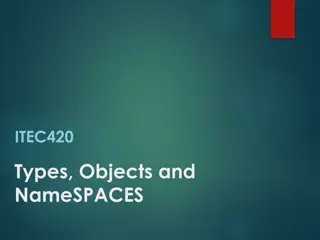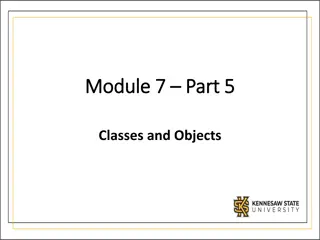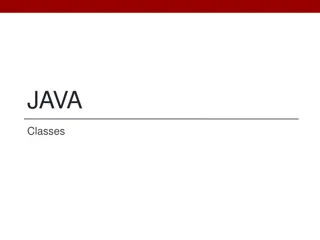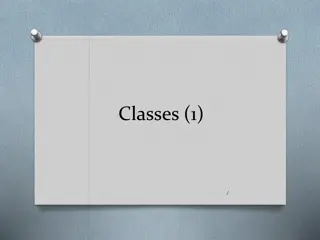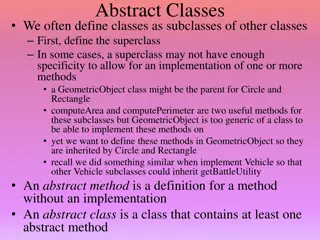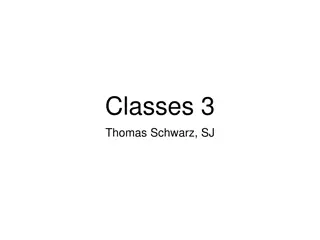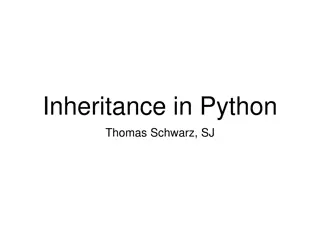
Understanding Object-Oriented Programming Concepts
"Explore the core concepts of Object-Oriented Programming (OOP), including data abstraction, encapsulation, and building a chocolate shop using OOP approach. Learn how OOP helps in organizing programs efficiently and enhancing code reusability and maintenance."
Download Presentation

Please find below an Image/Link to download the presentation.
The content on the website is provided AS IS for your information and personal use only. It may not be sold, licensed, or shared on other websites without obtaining consent from the author. If you encounter any issues during the download, it is possible that the publisher has removed the file from their server.
You are allowed to download the files provided on this website for personal or commercial use, subject to the condition that they are used lawfully. All files are the property of their respective owners.
The content on the website is provided AS IS for your information and personal use only. It may not be sold, licensed, or shared on other websites without obtaining consent from the author.
E N D
Presentation Transcript
Object-oriented programming OOP is a method for organizing programs which includes: Data abstraction Bundling together information and related behavior A metaphor for computation using distributed state: Each object has its own local state Each object also knows how to manage its own local state, based on method calls Method calls are messages passed between objects Several objects may all be instances of a common type Different types may relate to each other
Abstraction/Information Hiding One of the great benefits of using objects is the ability to abstract away details and hide unnecessary information from the user of the object. Think about the steering wheel in a car all you as the user needs to know is that turning it makes the car turn. You don t need to know the details of how it interacts with the axle and wheels of the car Information hiding also allows us to make improvements in code without impacting how the object is used.
Encapsulation Another benefit of classes is the idea of encapsulation. The class encapsulates the data that it contains This "hides" the data from the user doesn't allow direct access The class defines the ways the user can access and interact with the data so that the data's integrity is always maintained.
Building a chocolate shop The shop has products that have names, prices, nutrition information, and an inventory count There are customers who have names and addresses And there are payments that reference the customers and products and have payment information
The OOP approach We can use objects to organize our code for the shop: # Inventory tracking Product(name, price, nutrition) Product.get_label() Product.get_nutrition_info() Product.increase_inventory(amount) Product.reduce_inventory(amount) Product.get_inventory_report() # Customer tracking Customer(name, address) Customer.get_greeting() Customer.get_formatted_address() Customer.buy(product, quantity, cc_info) # Purchase tracking Order(customer, product, quantity, cc_info) Order.ship() Order.refund(reason) # Shop management ChocolateShop(name) ChocolateShop.signup_customer(name, address) ChocolateShop.add_product(name, price, nutrition) An object bundles together information and related behavior.
Python OOP terminology A class is a template for defining new data types. An instance of a class is called an object. Each object has data attributes called instance variables that describe its state. Each object also has function attributes called methods. Python includes special syntax to create classes and objects.
A fully coded class and usage # Define a new type of data class Product: def reduce_inventory(self, amount): self.inventory -= amount # Set the initial values def __init__(self, name, price, nutrition_info): self.name = name self.price = price self.nutrition_info = nutrition_info self.inventory = 0 def get_label(self): return "Foxolate Shop: " + self.name def get_inventory_report(self): if self.inventory == 0: return "There are no bars!" return f"There are {self.inventory} bars." # Define methods def increase_inventory(self, amount): self.inventory += amount pina_bar = Product("Pi a Chocolotta", 7.99, ["200 calories", "24 g sugar"]) pina_bar.increase_inventory(2)
Class instantiation (Object construction) pina_bar = Product("Pi a Chocolotta", 7.99, ["200 calories", "24 g sugar"]) Product(args) is often called the constructor. When the constructor is called: A new instance of that class is created The __init__() method of the class is called with the new object as its first argument (named self), along with any additional arguments provided in the call expression class Product: def __init__(self, name, price, nutrition_info): self.name = name self.price = price self.nutrition_info = nutrition_info self.inventory = 0
Instance variables Instance variables are data attributes that describe the state of an object. This __init__() initializes 4 instance variables: class Product: def __init__(self, name, price, nutrition_info): self.name = name self.price = price self.nutrition_info = nutrition_info self.inventory = 0 The object's methods can then change the values of those variables or assign new variables.
Method invocation This expression pina_bar.increase_inventory(2) calls this function in the class definition: class Product: def increase_inventory(self, amount): self.inventory += amount pina_bar.increase_inventory() is a bound method: a function which has its first parameter pre-bound to a particular value. In this case, self is pre-bound to pina_bar and amount is set to 2. It's equivalent to: Product.increase_inventory(pina_bar, 2)
Dot notation All object attributes (which includes variables and methods) can be accessed with dot notation: pina_bar.increase_inventory(2) That evaluates to the value of the attribute looked up by increase_inventory() in the object referenced by pina_bar. The left-hand side of the dot notation can also be any expression that evaluates to an object reference: bars = [pina_bar, truffle_bar] bars[0].increase_inventory(2)
All together now The class definition: # Define a new type of data class Product: # Set the initial values def __init__(self, name, price, nutrition_info): self.name = name self.price = price self.nutrition_info = nutrition_info self.inventory = 0 # Define methods def increase_inventory(self, amount): self.inventory += amount Object instantiation and method invocation: pina_bar = Product("Pi a Chocolotta", 7.99, ["200 calories", "24 g sugar"]) pina_bar.increase_inventory(2)
Exercise: Player class """ This class represents a player in a video game. It tracks their name and health. """ class Player: """ >>> player = Player("Mario") >>> player.name 'Mario' >>> player.health 100 >>> player.damage(10) >>> player.health 90 >>> player.boost(5) >>> player.health 95 """
Exercise: Player class (solution) """ This class represents a player in a video game. It tracks their name and health. """ class Player: def __init__(self, name): self.name = name self.health = 100 def damage(self, amount): self.health -= amount def boost(self, amount): self.health += amount
Exercise: Clothing class """ Clothing is a class that represents pieces of clothing in a closet. It tracks the color, category, and clean/dirty state. """ class Clothing: """ >>> blue_shirt = Clothing("shirt", "blue") >>> blue_shirt.category 'shirt' >>> blue_shirt.color 'blue' >>> blue_shirt.is_clean True >>> blue_shirt.wear() >>> blue_shirt.is_clean False >>> blue_shirt.clean() >>> blue_shirt.is_clean True """
Exercise: Clothing class (solution) """ Clothing is a class that represents pieces of clothing in a closet. It tracks the color, category, and clean/dirty state. """ class Clothing: def __init__(self, category, color): self.category = category self.color = color self.is_clean = True def wear(self): self.is_clean = False def clean(self): self.is_clean = True
Classes in environment diagrams class Product: def __init__(self, name, price, nutrition_info): def increase_inventory(self, amount): def reduce_inventory(self, amount): def get_label(self): def get_inventory_report(self): A class statement creates a new class and binds that class to the class name in the first frame of the current environment. Inner def statements create attributes of the class (not names in frames). View in PythonTutor
Dynamic instance variables An object can create a new instance variable whenever it'd like. class Product: def reduce_inventory(self, amount): if (self.inventory - amount) <= 0: self.needs_restocking = True self.inventory -= amount pina_bar = Product("Pi a Chocolotta", 7.99, ["200 calories", "24 g sugar"]) pina_bar.reduce_inventory(1) Now pina_bar has an updated binding for inventory and a new binding for needs_restocking (which was not in __init__()). View in PythonTutor
Class variables A class variable is an assignment inside the class that isn't inside a method body. class Product: sales_tax = 0.07 Class variables are "shared" across all instances of a class because they are attributes of the class, not the instance. class Product: sales_tax = 0.07 def get_total_price(self, quantity): return (self.price * (1 + self.sales_tax)) * quantity pina_bar = Product("Pi a Chocolotta", 7.99, ["200 calories", "24 g sugar"]) truffle_bar = Product("Truffalapagus", 9.99, ["170 calories", "19 g sugar"]) pina_bar.sales_tax truffle_bar.sales_tax pina_bar.get_total_price(4) truffle_bar.get_total_price(4)
Exercise: StudentGrade class """ This class represents grades for students in a class. """ class StudentGrade: """ >>> grade1 = StudentGrade("Arfur Artery", 300) >>> grade1.is_failing() False >>> grade2 = StudentGrade("MoMo OhNo", 158) >>> grade2.is_failing() True >>> grade1.failing_grade 159 >>> grade2.failing_grade 159 >>> StudentGrade.failing_grade 159 >>> """ def __init__(self, student_name, num_points): self.student_name = student_name self.num_points = num_points def is_failing(self): return self.num_points < ___
Exercise: StudentGrade class (solution) """ This class represents grades for students in a class. """ class StudentGrade: """ >>> grade1 = StudentGrade("Arfur Artery", 300) >>> grade1.is_failing() False >>> grade2 = StudentGrade("MoMo OhNo", 158) >>> grade2.is_failing() True >>> grade1.failing_grade 159 >>> grade2.failing_grade 159 >>> StudentGrade.failing_grade 159 >>> """ failing_grade = 159 def __init__(self, student_name, num_points): self.student_name = student_name self.num_points = num_points def is_failing(self): return self.num_points < self.failing_grade
getattr/hasattr built-ins Using getattr(), we can look up an attribute using a string getattr(pina_bar, 'inventory') # 1 hasattr(pina_bar, 'reduce_inventory') # True getattr() and dot expressions look up a name in the same way Looking up an attribute name in an object may return: One of its instance attributes, or One of the attributes of its class
Attributes are all public As long as you have a reference to an object, you can access or change any attributes. pina_bar = Product("Pi a Chocolotta", 7.99, ["200 calories", "24 g sugar"]) current = pina_bar.inventory pina_bar.inventory = 5000000 pina_bar.inventory = -5000 You can even assign new instance variables: pina_bar.brand_new_attribute_haha = "instanception"
"Private" attributes To communicate the desired access level of attributes, Python programmers generally use this convention: __ (double underscore) before very private attribute names _ (single underscore) before semi-private attribute names no underscore before public attribute names That allows classes to hide implementation details and add additional error checking.
Multiple instances There can be multiple instances of each class. pina_bar = Product("Pi a Chocolotta", 7.99, ["200 calories", "24 g sugar"]) cust1 = Customer("Coco Lover", ["123 Pining St", "Nibbsville", "OH"]) cust2 = Customer("Nomandy Noms", ["34 Shlurpalot St", "Buttertown", "IN"]) What are the classes here? Product, Customer How many instances of each? 1 Product, 2 Customers
State management An object can use instance variables to describe its state. A best practice is to hide the representation of the state and manage it entirely via method calls. >>> pina_bar = Product("Pi a Chocolotta", 7.99, ["200 calories", "24 g sugar"]) >>> pina_bar.get_inventory_report() "There are NO bars!" >>> pina_bar.increase_inventory(3) >>> pina_bar.get_inventory_report() "There are 3 bars total (worth $23.97 total)." What's the initial state? 0 bars in inventory What changes the state? increase_inventory() by changing the instance variable _inventory
Class vs. instance variables class Customer: salutation = "Dear" def __init__(self, name, address): self.name = name self.address = address def get_greeting(self): return f"{self.salutation} {self.name}," def get_formatted_address(self): return "\n".join(self.address) cust1 = Customer("Coco Lover", ["123 Pining St", "Nibbsville", "OH"]) What are the class variables? salutation What are the instance variables? name, address



